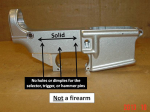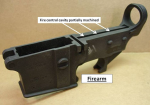BATFE Q&A on AR15 Receiver Blanks
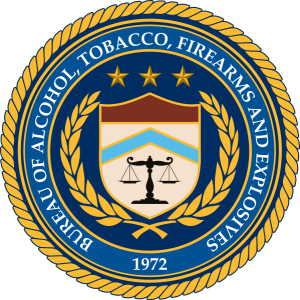 1. Is ATF aware of the receiver blanks, commonly referred to as 80% receivers?
1. Is ATF aware of the receiver blanks, commonly referred to as 80% receivers?
ATF routinely collaborates with the firearms industry and law enforcement to monitor new technologies and current manufacturing trends that could potentially impact the safety of the public.
2. What is an “80%” or “unfinished” receiver?
“80% receiver,” “80% finished,” “80% complete,” “unfinished receiver” are all terms referring to an item that some may believe has not yet reached a stage of manufacture that meets the definition of firearm frame or receiver found in the Gun Control Act of 1968 (GCA). These are not statutory terms or terms ATF employs or endorses.
3. Are “80%” or “unfinished” receivers illegal?
Receiver blanks that do not meet the definition of a “firearm” are not subject to regulation under the GCA. The ATF has long held that items such as receiver blanks, “castings” or “machined bodies” in which the fire-control cavity area is completely solid and un-machined have not reached the “stage of manufacture” which would result in the classification of a firearm per the GCA.
See the photos below for a comparison of which partial receivers are firearms and which are not:
- Receiver Blank: Not a Firearm
- Receiver Blank: Not a Firearm
- Receiver: Firearm
Gun Industry Sales Reflect a ‘New Normal’
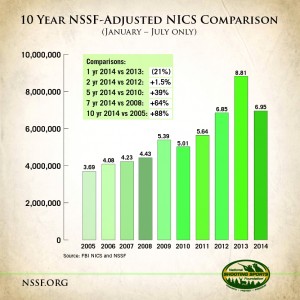 Last year was an extraordinary one for firearm sales, a year unlike any other in the industry’s history. That’s a fact to be mindful of when comparing estimated sales through the first seven months of 2014 with those of the previous year, notes Steve Sanetti, President and CEO of the National Shooting Sports Foundation, the trade association for the firearms and ammunition industry.
Last year was an extraordinary one for firearm sales, a year unlike any other in the industry’s history. That’s a fact to be mindful of when comparing estimated sales through the first seven months of 2014 with those of the previous year, notes Steve Sanetti, President and CEO of the National Shooting Sports Foundation, the trade association for the firearms and ammunition industry.
Remove the extraordinary 2013 from the rear-view mirror and sales of firearms in America still show an almost uninterrupted rise over the past 10 years, according to national background check figures adjusted by NSSF to reflect market activity. For the first seven months of 2014, total firearm sales rank as the highest in the last decade, with the one big exception of 2013 (see chart).
(A background check is mandatory for retail purchases of firearms. NSSF adjusts background check data from the FBI’s National Instant Background Check System to remove non-sales activity such as checks conducted for concealed carry permits. This results in NSSF-adjusted NICS data being a better indicator of market conditions than overall NICS data, though NSSF-adjusted NICS figures do not correlate one to one with firearm sales.)
From January through July 2014, NSSF-adjusted NICS figures total 6.95 million background checks against 6.85 million for 2012 and 5.64 million in 2011. In 2013, the seven-month figure was 8.81 million and the annual total was a record 14.8 million. Multiple factors account for last year’s sales surge, including a fear of additional firearms-ownership restrictions, which came to pass in states such as New York, Connecticut and Maryland, as well as increasing interest in owning firearms by women and former servicemen and women.
“Those who are hostile to firearms ownership are trying to suggest Continue reading
Remington Reboots R51
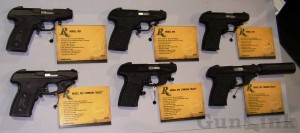 You may remember our coverage of Remington’s new R51 pistol from our SHOT Show 2014 coverage. It was a promising pistol that looked nice, felt good in the hand and, in theory, should have been a pleasant shooter. However, with no working models to try out at the SHOT Show range day, nobody got to see how it performed for themselves.
You may remember our coverage of Remington’s new R51 pistol from our SHOT Show 2014 coverage. It was a promising pistol that looked nice, felt good in the hand and, in theory, should have been a pleasant shooter. However, with no working models to try out at the SHOT Show range day, nobody got to see how it performed for themselves.
Once production models started making their way into the hands of shooters, reports started coming out about malfunctions and reliability issues. Then, as we mentioned on Twitter last week, Remington removed all mentions of the redesigned Pedersen handgun from their website and rumors started flying about what could be wrong with with it, whether it was going away for good, or what.
Remington has now released a statement with additional information about the botched first-run of R51s, saying that the pistols Continue reading
ATF Releases US Firearms Trace Data for 2013
 Following the Bureau of Alcohol, Tobacco, Firearms and Explosives recently released 2013 international firearms trace data, the ATF last week released aggregated firearms trace data for all US states and territories for calendar year 2013. Firearm traces provide critical investigative leads to law enforcement and can link a suspect to a firearm in a criminal investigation, identify potential traffickers, and detect local, interstate and international patterns in the sources and types of crime guns. Traces provide information on the movement of a crime gun from the manufacturer or importer through distributors and ultimately to the retail point of sale and purchaser.
Following the Bureau of Alcohol, Tobacco, Firearms and Explosives recently released 2013 international firearms trace data, the ATF last week released aggregated firearms trace data for all US states and territories for calendar year 2013. Firearm traces provide critical investigative leads to law enforcement and can link a suspect to a firearm in a criminal investigation, identify potential traffickers, and detect local, interstate and international patterns in the sources and types of crime guns. Traces provide information on the movement of a crime gun from the manufacturer or importer through distributors and ultimately to the retail point of sale and purchaser.
The 2013 report includes a state-by-state breakdown of types and calibers of firearms recovered and traced, source states, criminal offenses associated with the crime guns, time-to-crime, and age ranges of crime gun possessors at the time of recovery. Key findings of this year’s report include pistols as the most common firearm type recovered and traced, 9 mm as the top caliber recovered and traced, and 11.08 years as the average time-to-crime for crime guns recovered and traced in the U.S. and its territories. Continue reading
NSSF Video: Gun Crimes Plummet Even as Gun Sales Rise
A majority of Americans say they think gun crime has increased over the past 20 years, even though it has actually fallen dramatically, a recent Pew Research Center survey shows.
Sources: DOJ, ATF AFMER & USITC, Pew Research Center, National Safety Council, Gallup
Pennsylvania Lawyer Claims ATF Determination Allows for New Machine Guns
 Pennsylvania attorney Joshua Prince, Esq. is making a bold claim in his blog entry Did ATF’s Determination on NICS Checks Open the Door for Manufacture of New Machineguns for Trusts? that may be music to NFA enthusiasts’ ears.
Pennsylvania attorney Joshua Prince, Esq. is making a bold claim in his blog entry Did ATF’s Determination on NICS Checks Open the Door for Manufacture of New Machineguns for Trusts? that may be music to NFA enthusiasts’ ears.
In his post, Prince points out that, although the NFA regulations include language to include trusts under their purview, the 1968 Gun Control Act (GCA), codified in Title 18 of the United States Code, includes no such language. A 2013 inquiry by Dakota Silencer received an ATF response reading: “Unlike individuals, corporations, partnerships, and associations; unincorporated trusts do not fall within the definition of ‘person’ in the GCA.” As many already know, transfer by a person of a machine gun that was not registered before May 19, 1986 is forbidden by the Hughes Amendment to the Firearms Owners Protection ACT FOPA, which added subsection 922(0) to the law.
Prince’s conclusion is that:
[P]ursuant to 26 U.S.C. 5812 and 5822, an unincorporated trust may lawfully transfer and make machineguns, as it is not a “person” for purposes of the GCA and Section 922 only applies to “persons” as defined by the GCA.
This conclusion is Continue reading






